aNewDomain.net — The Total War series, arguably the best RTS since Starcraft, has come out with what can only be described as the next revolutionary edition: Rome II. Creative Assembly, the minds behind Total War, have taken the backbone of Shogun II and radically reinvented the series.
Read on for an in-depth analysis of this beastly new game, and check out the trailer here.

Photo credit: Total War Rome II
Setting
First off, lets look at the setting in Rome II. The world is crafted in the classical era of antiquity — the Roman Empire was on the rise and Greek concepts of Hellenism reigned throughout the (semi) Western World. Now, when I picture ancient history the first thought that fills my head is: How many freaks could there possibly be in one era? Rome II lives up to this multi-cultural phenomenon. It contains a plethora of factions, coming from the forests of Iberia to the jungles of India and everything in-between.
As a fan of the Total War series, this diversity is a radical change from the homogenous Japanese setting of Shogun II. Even for those who aren’t familiar with the Total War series, Rome II will blow you away with the sheer diversity of in-game factions — totaling 117 according to the Creative Assembly.
This makes for some great cultural immersion, as players are forced to think like the real generals that led those armies. Personally, I’m a huge fan of the change. It allows me to roleplay military geniuses like Hannibal or Caesar, which is a far more entertaining alternative than attempting to reenact those cultures in real life.
Gameplay
Let’s talk about gameplay. Rome II contains the same real time and turn-based strategy gaming as in previous Total War renditions, but there are some differences this time around.
For one, raising armies has been completely overhauled. Instead of generating one unit at a time, and inevitably moving nameless stacks around the map, all armies now have distinct names. Using WWII lingo (ie. 1st army, 2nd army) simply to keep up with my troops was frustrating. Now the armies have identities, names like the 10th legion or bloodhounds.

Photo Credit: Total War Rome II
According to Creative Assembly, it gives the troops more meaning. Instead of saying, “I’ll take this army and move it here” (boring), you will think, “the 5th legion needs backup, better bring in the 10th!” Armies even have traditions, events that symbolize the reputation of a well decorated unit in battle, like the 101st airborne.
The number of armies is now limited based on how much territory a faction owns, which allows for intensely big battles, and no more huge, unrealistic stacks running across the map as in previous games.
Real time battles have also changed radically with the addition of combined land and naval battles. As demonstrated in the Siege of Carthage historical battle, players can now go D-Day style and send in marines to support their land troops.
Naval battles have been diversified too, as different cultures have different navies. For example, Mediterranean navies have classic galley style ships, which are primarily ramming vessels. I’ve even seen a galley ram a ship in half! Epic.

Photo Credit: Total War Rome II
Land battles haven’t changed much since Shogun II. Same epic combat animations, and this time the troops do talk like real soldiers. Seeing one’s comrade being blown apart, or being ambushed by barbarians, does a lot to shake a soldier’s psyche.
Management
Province management on the campaign map has radically changed as well, with each province divided into subdivisions. There are 57 total provinces, divided into 173 regions, which allows for less siege battles and more open field attacks.
As a veteran of the Total War series, I am tired of traditional siege battles. They usually involve huge masses of men in a giant mob rush towards a center point with no strategy whatsoever.
City management has also been revamped — the player can now watch the city expand in real time on the campaign map, plus confetti falls down whenever a new building is finished. Nice touch CA.
Photo credit: memegenerator.net
A new, fascinating feature defines the campaign of Rome II. The political system.
A wise (in-game) Roman once said, “If I had a choice between the senate and a pit of rattlesnakes, I’d pick the rattlesnakes, they’re safer.” Rome II builds upon this proverb extremely well as Rome and Carthage are divided into three political families, each in a cutthroat struggle for power.
As a Roman family, the player has the option of becoming Emperor, which of course will bring him the ire of the other families. This a huge bonus for Caesar fans as it allows them to cross their own Rubicon. Also, all factions are prompted with political decisions, which lets players take dissenters “out of the picture”.
In all Total War games a huge amount of excitement lies in the ability to play multiple factions, and Rome II does not disappoint. Currently CA has released eight main playable factions, with Pontus and the Seleucid Empire as free-DLCs, or as Total War fans call them, Free-LCs.
I felt like a kid in a candy shop when I first played. There was a faction for all cultures, from the epic barbarian Suebi to the civilized Macedon. I was initially disappointed with the small number upon release, but as in all Total War games, there will be faction pack DLCs, such as the Greek City-States or the Nomad Riders.
Despite the slew of awesome new features, the multiplayer aspect of Rome II is lacking. The widely successful Avatar Conquest mode of Shogun II, where players could create their own hero and fight under their own banner, seemed like an excellent place to start. After all, when customization was so successful in the homogenous setting of Feudal Japan, imagine the epicness of customization in an era with such a diverse population of cultures.
Sadly this is not the case, as CA decided to return to their traditional faction vs. faction multiplayer.
C’mon guys, are going to be this lazy and revert to a concept that’s been stale since Shogun II? It wouldn’t be so bad if players could experience the full diversity of antiquity, but nope, multiplayer is only available as the playable factions, which ends up as ten groups, sixteen if you get all the DLCs. Not CA’s proudest moment.
Overall, Rome II gets a 9/10. The campaign is extraordinary, the graphics are absolutely hollywood level in epicness and it has a wide variety of factions for great gameplay. It’s major let down is multiplayer — not to metion the fact that you will need a computer as powerful as Chuck Norris to have a hope of even running a game of this scale. Also, the addition of 117 factions causes quite a lagfest between turns. If you have the computer for Rome II, and I know some of you do, I would highly recommend getting this game. For me and my ol’ Windows 7 though, I’ll stick with Shogun II.
For aNewDomain.net, I’m Fegelin Puching Zhang.
Based in Chicago, Fegelein Puching Zhang is our gaming scribe at aNewDomain.net. Read more of his work here or contact Fegelein at puching@anewdomain.net.















[…] of Tanks, to its credit, is good because it uses a tech tree like in Total War or Hearts of Iron, where research points allow players not to waste money and resources on […]